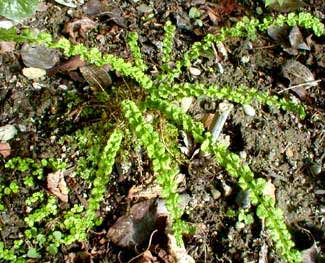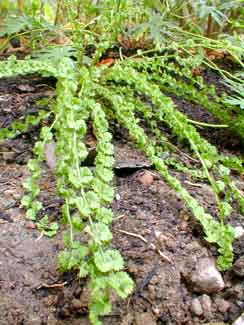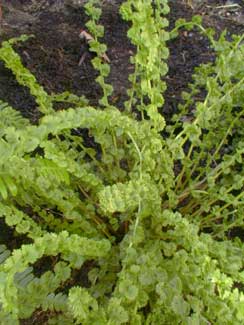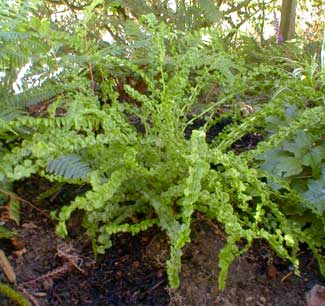
Tatting Fern; aka,
Beaded Lady Fern
"my ignorance of the stars is formidable,
also of dogs & ferns
except that around my house
one destroys the other."
-John Berryman,
1968
1968
 The grower of this fern, Sundquist Nursery, described Athyrium filix-femina 'Frizelliae' as "surreal" & "a Jurassic Park escapee." The Northwest grower does not recommend it for deep shade, but for part sun or part shade.
The grower of this fern, Sundquist Nursery, described Athyrium filix-femina 'Frizelliae' as "surreal" & "a Jurassic Park escapee." The Northwest grower does not recommend it for deep shade, but for part sun or part shade.The catalog for another leading local nursery, Heronswood, likewise recommends them for bright shade. Inland, however, they would more certainly be part to full shade, requiring protection from too much light, for it is not at all heat-hardy. It is extremely cold-hardy & suited to zones three through eight.
 After its long winter absence, it returns somewhat late, showing itself in dribs & drabs until there's almost enough plant to appreciate at mid-April, as shown in the photo above (the second photo is from July; the third & fourth photos are from September). It's worth the wait, being one of the most beautiful oddities of the fern world.
After its long winter absence, it returns somewhat late, showing itself in dribs & drabs until there's almost enough plant to appreciate at mid-April, as shown in the photo above (the second photo is from July; the third & fourth photos are from September). It's worth the wait, being one of the most beautiful oddities of the fern world.This cultivated form was preserved from a strain first spotted in Ireland in the County Wicklow garden of a certain Mrs. Frizell, in 1857. "It grew between two boulders so fast & with so little soil," said Mrs. Frizell, "that it was with great difficulty my husband removed it."
Rarely so tall as two feet high & wide, it is typically only about one foot high, & eighteen inches wide. Individual one-foot-long fronds are a mere one-inch wide along their whole length, with a series of rounded or miniature fan-shaped pinnae often described as either like rows of beads, or like tatting lace. To me the leaves most resemble ribbons of ricrac. Someone who actually tats described the Tatting Fern as having the appearance of "multi-picoted rings."
 It's a most unusual cultivar, but unstable, so that the leaves may normalize with age with less of the beaded-necklace look. It will not grow true from spoors, & is not even reliably stable from tissue-cultured production, thus a good specimen, even quite small, will be a little pricier than other cultivars of "Lady Fern."
It's a most unusual cultivar, but unstable, so that the leaves may normalize with age with less of the beaded-necklace look. It will not grow true from spoors, & is not even reliably stable from tissue-cultured production, thus a good specimen, even quite small, will be a little pricier than other cultivars of "Lady Fern."It should be selected already well-grown, since brand new starts will not yet have proven themselves to possess good form. For home-propogation, it can be divided in late winter or early spring before its leaves start to reappear, probably no oftener than every three or four years.
When young it can seem a bit stringy & merely odd, likeable for its strangeness but not showy. Ours is presently just such a young plant. But when it is in its prime, it is like a heap of dreadlocks, so gorgeous that even non-fern people admire it without pissin' & moanin' that ferns lack blossoms. It thus deserves a central display location in the garden, for it is truly a specimen-worthy item. Unsuprisingly, it was given the Award of Garden Merit by the Royal Horticultural Society.